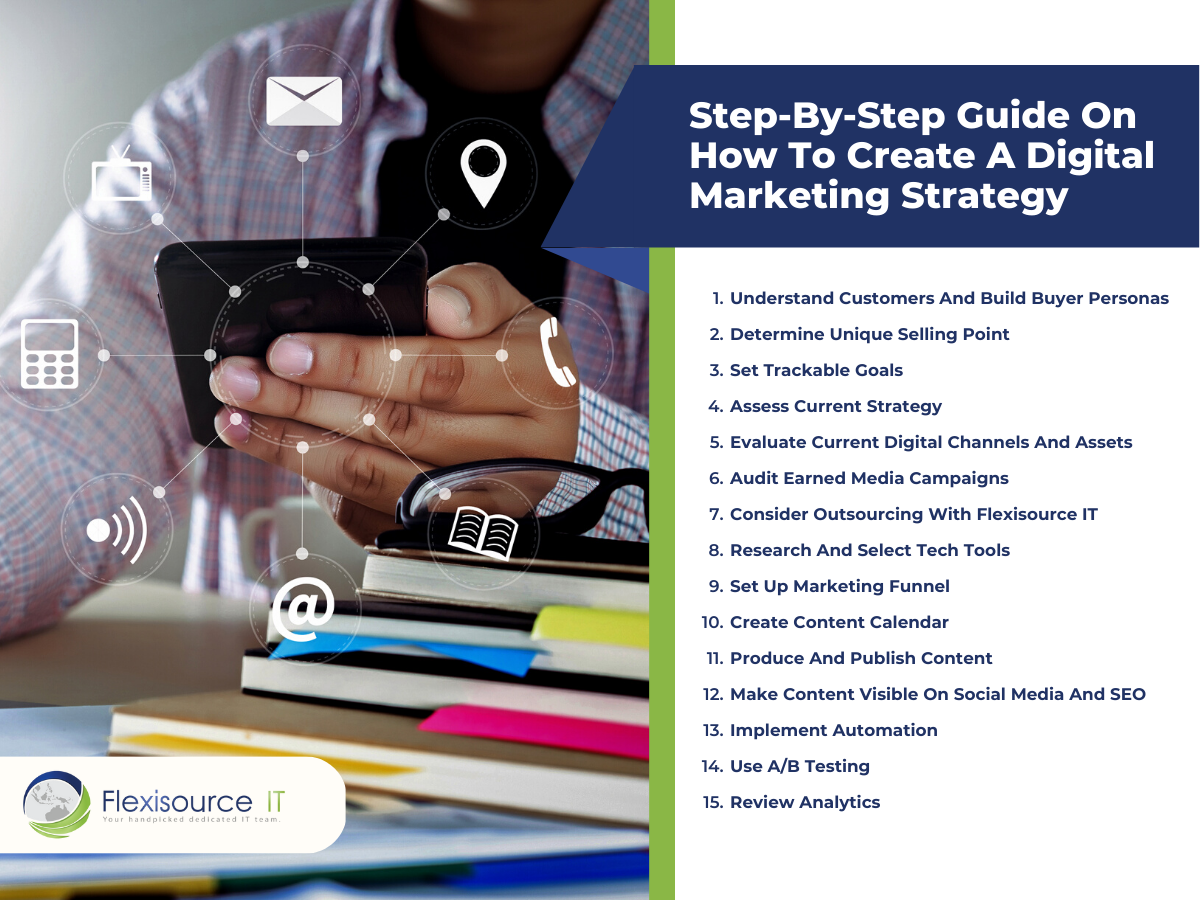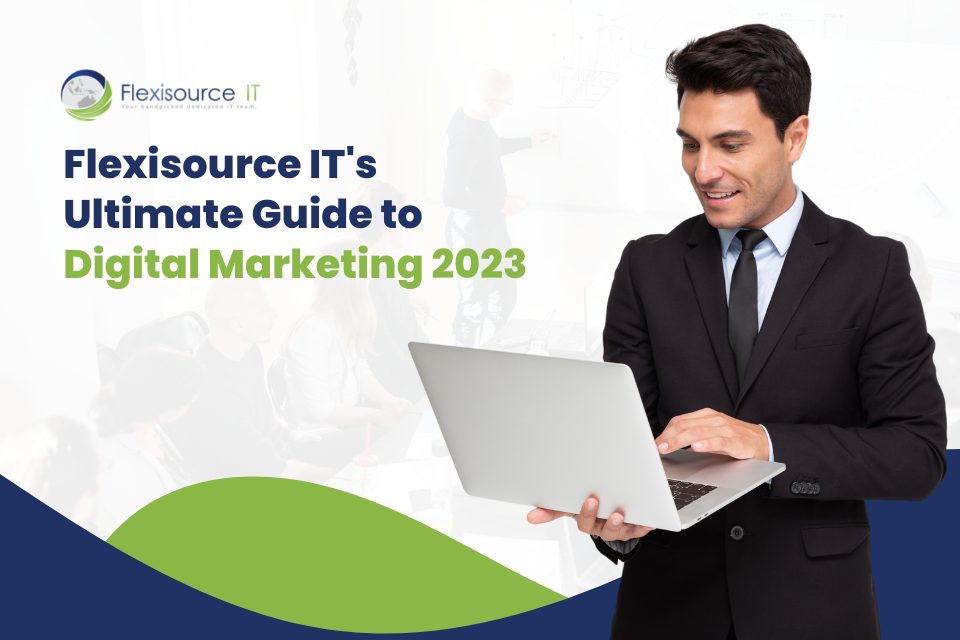Here at Flexisource IT, we understand that digital marketing is not a “one-size-fits-all dress.” You need to know what works for your brand, the specific fit that you want, and the reason why you want that “dress.” So, to help you get the perfect fit, we put together this digital marketing guide.
In this ultimate guide to digital marketing, we are going to touch on the basics and work our way to creating your marketing strategy and a couple of tactics that help grow a business.
What is Digital Marketing
As its name suggests, digital marketing is an online avenue for brands to reach their audience and customers. Its principles are largely based on what we already know from traditional marketing. The only difference between traditional and digital marketing is how and where companies promote and sell their products and services.
As such, digital marketers possess the foundational knowledge from it and marry it with the technical know-how to manoeuvre the digital marketing landscape.
8 Types of Digital Marketing
The stage in question is the vast expanse of the internet. Of course, with the digital space being so broad, there are bound to be many channels of entry for brands.
Search Engine Optimization (SEO)
SEO focuses on search engine platforms, such as Google and Bing.
Here, SEO is the practice of optimising a website or online content to increase its chances of gaining more visibility and climbing the ranks of the search engine results pages (SERPs).
There are a lot of things that go into optimising a website for SEO. These included on-page and technical aspects, such as website structure and content, targeting relevant keywords, building quality backlinks, and improving user experience to increase organic (non-paid) traffic and enhance website authority.
Pay-Per-Click (PPC)
PPC is an advertising model wherein brands pay a fee whenever their ad is clicked. It is usually done through platforms such as Google Ads, Bing Ads, and social media advertising platforms. Likewise, PPC is a cost-effective digital marketing tool to drive traffic and conversions to a website.
However, brands need careful planning, targeting, and optimisation to achieve a positive return on investment (ROI). Or else, it could be money down the drain
Social Media Marketing
Social media is where the audience and brands have two-way communication, unlike the other type of digital marketing mentioned here. Companies can engage with their audience on platforms such as Facebook, Instagram, Twitter, LinkedIn, YouTube, and TikTok.
Furthermore, social media marketing involves creating and sharing text, images, and video content. These are designed to appeal to the audience and encourage all forms of engagement, such as likes, comments, shares, and follows. Through these engagements, brands can promote their products or services, build brand awareness, engage with customers, and drive website traffic.
Content Marketing
As the saying goes, “Content is king!” rings true for digital marketing.
Content marketing involves creating and sharing valuable, relevant, consistent content to attract and retain a clearly defined audience. It comes in many forms, such as blog posts, articles, infographics, videos, podcasts, and social media posts, to name a few.
Furthermore, content is used to provide value to the audience. So certain content can be about addressing their needs, interests, and pain points rather than directly promoting a product or service.
Ultimately, content marketing aims to provide value to make it worthwhile and drive profit through customer action.
Email Marketing
Email marketing focuses on one channel, which is email.
Basically, it is a strategy that brands use to send out commercial messages to a group of people who have already subscribed. These messages can be in the form of newsletters, promotional offers, updates, or any other type of content. The point is to engage with people and convert them into paying customers.
Likewise, email marketing is considered a cost-effective strategy since brands directly reach out, nurture these relationships, build loyalty, and drive profits through one channel.
Moreover, it can also be automated and personalised, based on various criteria such as demographics, interests, behaviour, and purchase history,
Mobile Marketing
Mobile marketing includes text messages from companies, mobile app advertising, mobile web advertising, and branded push notifications, just to name a few. Marketers use this to provide tailor-fit content, usually by geo-location or time.
Like email marketing, mobile marketing is also regarded as cost-effective. This is an avenue where a brand sends commercial messages to inform potential clients about their marketing activities or campaigns.
Marketing Analytics
As the name suggests, marketing analytics refers to analysing the data gathered from marketing activities.
It uses data analysis and statistical modelling techniques to measure the efficacy of the campaigns and strategies executed by a brand. The data collected comes from various sources like website traffic, social media engagement, sales figures, and customer behaviour.
The data collected also allow marketers to glean valuable insights into the performances of the marketing activities and what can be done to improve them. Ultimately, marketing analytics help brands make better decisions to achieve their goals.
Affiliate Marketing
Affiliate marketing is more like an arrangement between two parties. Party A is the brand that rewards Party B, the affiliates, for increasing sales or driving up traffic. Affiliates can be individuals or a group with a large following.
In affiliate marketing, brands tap into affiliates’ audiences to expand their reach and promote their products to a wider audience. In addition, it saves brands from investing heavily in advertising or marketing campaigns but still yields the results they want.
Pros and Cons of Digital Marketing
There are several other strategies and tactics that fall under the broad umbrella of marketing. That is why a good digital marketing guide can greatly help marketers since they can always go back to it.
That said, it is essential to note that it has limitations. We believe that knowing these can also be helpful for your digital marketing guide. So, we listed below its pros and cons.
Pros
- Cost-Effective
- Broad Reach
- Easy Branding
- Opportunity To Present Expertise
- Sales Funnel
- Personalised & Accurate Targeting
- Trackable Results
- Helps Grow The Business
Cons
- Cyber Security & Privacy Issues
- Accessibility Challenge
- Tech Reliance
- Setbacks
- Fierce Global Competition
- Negative Feedback
- Anti-Brand Activities
Step-By-Step Guide On How To Create A Digital Marketing Strategy
Whether it is digital marketing for beginners or for seasoned experts, a well-planned strategy is a staple and a must-have. Having a strategy can make a world of difference.
This is because a good strategy serves as your road map. In addition, it also outlines your goals, intended target audience, messaging, and marketing tactics. All these are necessary to reach and effectively engage your audience through the channels available to you.
Of course, you can opt to follow a digital marketing strategy template available online. But, here at Flexisource IT, we understand that marketing is not a “one-size-fits-all dress.” So, we broke it down into a series of steps instead so you can create your own tailor-fit strategy.

Understand Customers And Build Buyer Personas
To build a buyer persona, it is important to gather information about your target audience. These are done through a variety of methods, such as online surveys, customer interviews, and social media analytics.
Determine Unique Selling Point
When developing a strategy, looking at digital marketing examples is a good practice. However, not when it comes to determining your unique selling point (USP).
In this case, you need to look inward. You will need to identify what makes your product or service unique and valuable. You can also conduct market research and get customer feedback to identify the important aspects of your product or service.
Set Trackable Goals
The next step is to measure the efficacy of your strategy. To do that, you need to set trackable goals.
In this part, it can be helpful to use a digital marketing strategy framework. Following a framework can provide a structured approach to plan, implement, and measure the success of your digital marketing efforts. In addition, it makes it easier to identify specific, measurable, and achievable objectives that align with a company’s goals.
Assess Current Strategy
To get the results you need and achieve your goals, it is important to assess your digital marketing strategy. A great place to start is by reviewing key performance indicators (KPIs) and cross-checking them with your current goals. This enables you to pinpoint areas where you are underperforming and identify opportunities for improvement.
Evaluate Current Digital Channels And Assets
This step is pretty straightforward. You need to evaluate all digital channels and assets to ensure they are still aligned with your goals and producing results. In addition, you can identify strengths to build on, weaknesses to address, and opportunities to improve further.
Audit Earned Media Campaigns
Auditing earned media campaigns starts by reviewing media coverage and online reviews to assess the sentiment and the social impact of your brand’s messaging. Next, evaluate your relationships with influencers and affiliates and check if they are performing well.
Lastly, review your social media engagement and community management efforts. All these are meant to ensure that you are engaging with your audience and assessing their overall perception of the brand.
Consider Outsourcing With Flexisource IT
Part of your strategy is to also take into consideration your team’s skill set, bandwidth, and effectiveness. If you feel like your team will not be able to meet the goals you have set, then partnering with an outsourcing company is something you should seriously consider.
Third-party providers, like Flexisource IT, can help you with content creation, social media management, SEO, and PPC. In addition, these are teams of digital marketing experts that can help improve your digital marketing efforts.
Research And Select Tech Tools
Tools are just as important for your marketing activities. That is why you need to carefully consider, research, and select the tech tools you and your team will use.
A good way to start is by identifying the key areas of your strategy where technology can provide value, like social media management, email marketing, and analytics. Then consider the compatibility with your existing systems and workflows.
Lastly, since there are plenty of options available online, make sure to compare the features and prices of each one. It is encouraged to do a trial run first before fully committing.
Set Up Marketing Funnel
A marketing funnel guides your interested audience from potential customers into actual paying customers from the initial awareness stage through making a purchase or another intended action.
Here is a general flow:
- Identify touchpoints
- Create content
- Tweak messaging for each stage: awareness, consideration, and conversion
- Optimise with a clear call to action (CTA)
- Analyse funnel performance
- Regularly test
Create Content Calendar
Now that you have the foundation of your strategy, you need to create a content calendar. This will serve as the guide and tracker for all the plans, schedules, and content created.
When creating a content calendar, make sure to factor in events such as seasonal trends, industry events, and key dates. But still, be flexible enough to pivot and make content for any social trends that can be applied to the brand.
Produce And Publish Content
Since you already have a content calendar, the next step would be to create the content and publish it. However, you must always consider the following:
- Formaat
- Tone
- Messaging
- Value
In addition, make sure to use the necessary tech tools to improve the content produced, such as keyword search and competitor analysis tools.
Make Content Visible On Social Media And SEO
Publishing the content you created is only the first half of it. Next, you need to increase its visibility.
For published blog articles, you need to optimise your content for search engines using keyword research, meta tags, and on-page optimization. For content on social media channels, an active promotion like asking your audience to like and share can also help. Another option is to use paid ads for a wider reach.
Implement Automation
Automation can save you a lot of time for other important things. To start, you should identify repetitive tasks and processes that can be automated. After that, you just need to create workflows that trigger automated actions based on specific user behaviours or other criteria.
Make sure to regularly check your automated workflows and make adjustments. This is one way to ensure they remain effective and aligned with your overall strategy.
Use A/B Testing
Also known as “split testing,” this is a method of comparing two versions of a digital marketing element to determine which one performs better. These differences can be a headline or a call to action.
After that, you just need to split your audience into two random groups and show each one a different version. Make sure to track and measure the performance of each version using relevant metrics. The point is to find the best-performing combination.
Review Analytics
The last step in this digital marketing guide to creating your strategy: Review your analytics. This is an essential part that will help you analyse your data to identify patterns and trends.
The insights you get from your analytics will contribute to refining your tactics and messaging. In addition, this will ensure you are effectively reaching your target audience.
Digital Marketing Strategies To Help Grow Your Business
Aside from creating a strategy, it is important to implement tactics that will help you grow your business. Here are a couple of strategies that you can use to help you achieve your business goals.
Directory Listings
Directory listings can help grow a business by increasing the online visibility and credibility of the brand. Basically, you just need to add your brand to popular directories like Google My Business, Yelp, and the Yellow Pages.
It is a great way for potential customers to see reviews and ratings from real people. These will help build trust and credibility for your business.
Local Citations
A local citation refers to any mention of your business’s name, address, and phone number on other websites. These include online directories, social media platforms, and blog articles.
These help search engines regard your business as trustworthy and an authority figure, which can contribute to climbing higher in search rankings and increasing visibility.
Google My Business
Google My Business is a free tool provided by Google that allows businesses to manage their online presence across their platform. With this, you can increase your visibility to potential customers who are searching for your products or services in your local area.
Plus, Google My Business also provides valuable insights and analytics for your business. These include how users interact with your listing, which allows you to adjust your strategy and improve your online presence.
Blogging
Becoming a thought leader in your industry through blogging is one way to improve your search engine ranking and help grow your business.
To do this, you need to produce high-quality blog content. Then each one should be optimised for search engines and promoted through social media and other channels as well. Keep in mind that the best kind of content provides value to your audience.
Guest Blogging
Guest blogging is blogging. But instead of posting the content on your own website, this is published on another brand’s website. Aside from increasing your business’s online presence, this can also help build a mutually beneficial relationship with other companies.
Similar to blogging for your own website, the article you produce should provide value. In this case, it should also align with the intent of the other brand.
Backlinking
Backlinking is the process of getting links from other websites to your own website. It is an effective strategy to improve your brand’s credibility. In addition, it is also another great way to boost exposure and improve search engine ranking.
To do this, you need to pinpoint high-quality sites that have a high domain authority and are relevant to your industry. Then, you need to reach out to the website owner and explain how your content could benefit their audience.
Once a site owner accepts your pitch, all you need to do is to create the content, have it published, promote it, and monitor its performance.
Social Media Posts
Another way to boost your brand’s exposure is through social media posts. Just like blogging, providing value to your audience via your social networking channels can get you the same desired results.
For social media posting, the content you create should be bite-sized, engaging, and informative or entertaining. In addition to consistently posting, you should take this time to have a two-way conversation with your audience.
Digital Marketing Resources And Tools To Check Out
Speaking of providing value, in this digital marketing guide, we also added a couple of helpful resources and tools that are easily accessible to you right now.
-
- Moz gives you actionable insight into the world of SEO.
- Social Media Examiner provides in-depth guides for everything under digital marketing.
- Ahref is regarded as one of the best SEO tools. Like a Swiss army knife, it provides plenty of features.
- Google Digital Garage provides an extensive and holistic cover of digital marketing.
-
- Hubspot Courses and Certifications is one of the best platforms to get digital marketing certifications since they offer marketers a collection of 15 certification tracks to choose from.
- Wordstream PPC University is an incredible resource for marketers who are looking to improve their knowledge about PPC advertising.
Never Stop Learning
Digital marketing is an ever-evolving field. On top of that, customer preferences are dynamic and tech innovations are always being rolled out.
That is why it is important for marketers to stay up-to-date with the latest trends and strategies and adapt these to a brand’s digital marketing strategy. Luckily, there are a lot of digital marketing guides like this available online to help you do just that.
Of course, you do not have to do it all by yourself.
You can boost your digital marketing capabilities with a team of experts with Flexisource IT! You will get better results to ensure you engage your target audience and reach your business goals. Plus, you also have the opportunity to learn a lot through collaboration.
There is always room for improvement, especially with digital marketing! Check out our digital marketing services today and get in touch with us to get started.







